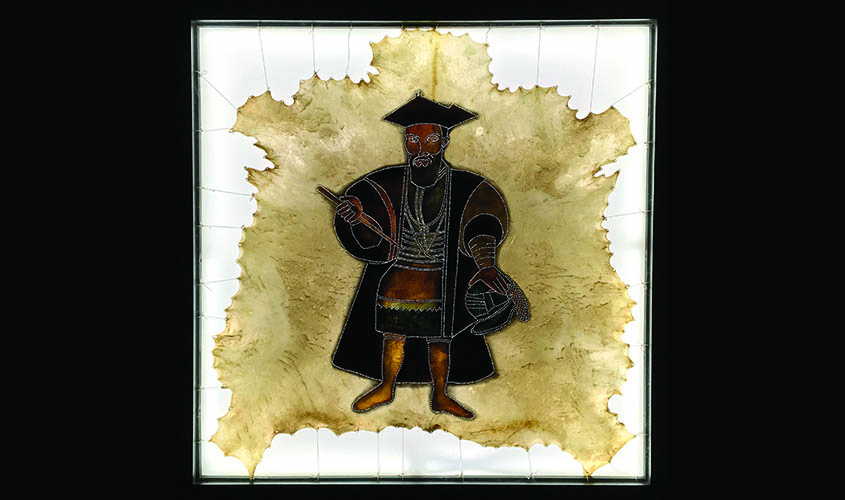K.M. Madhusudhanan’s solo exhibition, entitled Granite Lamp & Mirror, includes oil paintings, sculptures, and ink and charcoal drawings, produced by the artist in the last two years.
Continuing his two-tier engagement with global wars, and cinema as a historical and cerebral medium, the show opens up questions of image-making and identity, refracted through the lens of politics. The title of the exhibition cites Sri Narayana Guru’s revolutionary socio-religious interventions in the public realm. With this exhibition, the artist’s new works initiate a series of hundred works in conversation with and mirroring Narayana Guru’s philosophical text Atmopadesa Satakam or One Hundred Verses on Self-Instruction.
Madhusudhanan engages with age-old traditions and cultural identity through the art of Tholpavakoothu or shadow puppetry in Kerala, adapting the technique to create perforated goat-skin canvases then articulated with charcoal and ink. Light as a medium and philosophical touchstone runs through Madhusudhanan’s oeuvre, whether in the creation of film, the metaphor of the lamp, or the stark tenebrism inspired by the lurking darkness of the 19th century Spanish painter, Francisco Goya’s later art.

This darkness is reflective of the state of the world as the artist sees in history and the present—through colonial-era incarcerations, present-day casteism as relentlessly attached to historical reality, the curtailing of the freedom of speech and so on. Contemporary global wars and cross-cultural issues including refugee crises, has had an influence on his art, which is taken further now with an interest in the rise and fall of communist regimes throughout the world.
Madhusudhanan has worked with the medium of cinema extensively, engaging with subjects through the medium, and in turn engaging with the subject of cinema as medium. His series of works surrounding cinema titled Archeology of Cinema is taken forth in this exhibition, the medium deconstructed in its physical apparatuses, embodying the revolutionary impulse of industrialisation in the mechanics construed. Comparisons are made in the physical similarities between technologies. Loudspeakers, fighter jets, lamps, gears, and wheels – they are used as conjunctive imagery.
In his filmic constructed images, the artist betrays his enduring fascination with early Indian cinema as historical medium, replicating film stills and figures from the silent era. Similarly, Madhusudhanan insists on making series of images rather than the singular in imitation of the filmic language. A particular fascination towards the technological equipment and “machinery of moving images” is shown in the rudimentary forms of filmic construction. Such is a continuation of the themes explored in his 2008 feature film Bioscope. Concerned with reproduction of imagery and the succession through the moving image, the darkness held in the paintings invite the viewer into the cinematic theatre of the cruelties of global war.
The show is own view at Delhi’s Vadhera Art Gallery till 25 October

